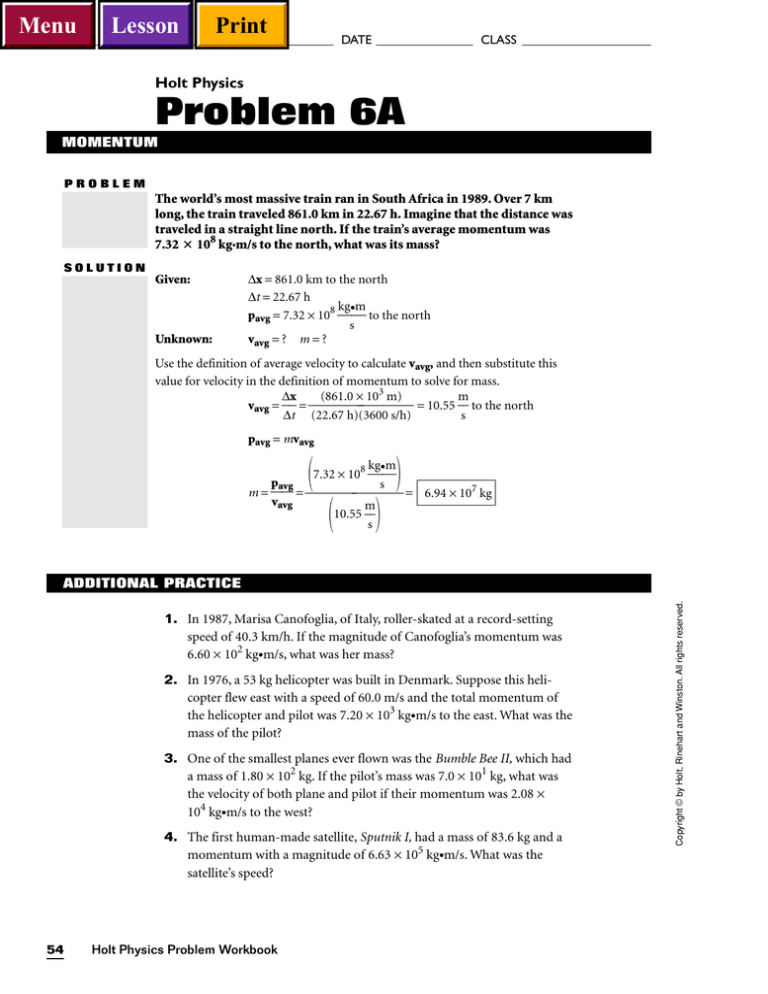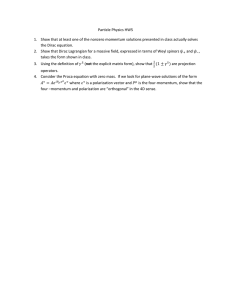
Menu
Lesson
Print
NAME ______________________________________
DATE _______________ CLASS ____________________
Holt Physics
Problem 6A
MOMENTUM
PROBLEM
The world’s most massive train ran in South Africa in 1989. Over 7 km
long, the train traveled 861.0 km in 22.67 h. Imagine that the distance was
traveled in a straight line north. If the train’s average momentum was
7.32 108 kg•m/s to the north, what was its mass?
SOLUTION
Given:
Unknown:
∆x = 861.0 km to the north
∆t = 22.67 h
kg•m
pavg = 7.32 × 108 to the north
s
vavg = ? m = ?
Use the definition of average velocity to calculate vavg, and then substitute this
value for velocity in the definition of momentum to solve for mass.
(861.0 × 103 m)
∆x
m
vavg = = = 10.55 to the north
∆t (22.67 h)(3600 s/h)
s
pavg = mvavg
kg•m
7.32 × 108
pavg
s
m = = = 6.94 × 107 kg
vavg
m
10.55
s
1. In 1987, Marisa Canofoglia, of Italy, roller-skated at a record-setting
speed of 40.3 km/h. If the magnitude of Canofoglia’s momentum was
6.60 × 102 kg•m/s, what was her mass?
2. In 1976, a 53 kg helicopter was built in Denmark. Suppose this helicopter flew east with a speed of 60.0 m/s and the total momentum of
the helicopter and pilot was 7.20 × 103 kg•m/s to the east. What was the
mass of the pilot?
3. One of the smallest planes ever flown was the Bumble Bee II, which had
a mass of 1.80 × 102 kg. If the pilot’s mass was 7.0 × 101 kg, what was
the velocity of both plane and pilot if their momentum was 2.08 ×
104 kg•m/s to the west?
4. The first human-made satellite, Sputnik I, had a mass of 83.6 kg and a
momentum with a magnitude of 6.63 × 105 kg•m/s. What was the
satellite’s speed?
54
Holt Physics Problem Workbook
Copyright © by Holt, Rinehart and Winston. All rights reserved.
ADDITIONAL PRACTICE
Menu
Lesson
Print
NAME ______________________________________
DATE _______________ CLASS ____________________
5. Among the largest passenger ships currently in use, the Norway has
been in service the longest. The Norway is more than 300 m long, has a
mass of 6.9 × 107 kg, and can reach a top cruising speed of 33 km/h.
Calculate the magnitude of the ship’s momentum.
Copyright © by Holt, Rinehart and Winston. All rights reserved.
6. In 1994, a tower 22.13 m tall was built of Lego® blocks. Suppose a block
with a mass of 2.00 g is dropped from the top of this tower. Neglecting
air resistance, calculate the block’s momentum at the instant the block
hits the ground.
Problem 6A
55
Menu
Lesson
Print
Momentum and Collisions
Chapter
6
Additional Practice 6A
Givens
Solutions
1. v = 40.3 km/h
p = 6.60 × 102 kg • m/s
6.60 × 102 kg • m/s
p
m = =
= 59.0 kg
v (40.3 × 103 m/h)(1 h/3600 s)
ptot = mh v + mp v
2. mh = 53 kg
v = 60.0 m/s to the east
ptot = 7.20 × 103 kg • m/s to
the east
7.20 × 103 kg • m/s − (53 kg)(60.0 m/s)
ptot − mhv
=
mp =
v
60.0 m/s
7.20 × 103 kg • m/s − 3.2 × 103 kg • m/s 4.0 × 103 kg • m/s
mp = = = 67 kg
60.0 m/s
60.0 m/s
II
2
3. m1 = 1.80 × 10 kg
1
m2 = 7.0 × 10 kg
ptot = 2.08 × 104 kg•m/s to
the west
4
4
−2.08 × 10 kg•m/s
−2.08 × 10 kg•m/s
p
=
v = tot
=
2
1
2.50 × 102 kg
m1 + m2 1.80 × 10 kg + 7.0 × 10 kg
v = −83.2 m/s = 83.2 m/s to the west
= −2.08 × 104 kg•m/s
4. m = 83.6 kg
HRW material copyrighted under notice appearing earlier in this book.
p = 6.63 × 105 kg•m/s
5. m = 6.9 × 107 kg
p 6.63 × 105 kg•m/s
v = = = 7.93 × 103 m/s = 7.93 km/s
m
83.6 kg
p = mv = (6.9 × 107 kg)(33 × 103 m/h)(1 h/3600 s) = 6.3 × 108 kg • m/s
v = 33 km/h
6. h = 22.13 m
m = 2.00 g
g = 9.81 m/s2
1
mgh = 2mvf 2
vf = 2g
h
p = mvf = m 2g
m/s
m)
h = (2.00 × 10−3 kg) (2
)(
9.
81
2)(2
2.
13
p = 4.17 × 10−2 kg • m/s downward
Additional Practice 6B
1. m = 9.0 × 104 kg
vi = 0 m/s
vf = 12 cm/s upward
F = 6.0 × 103 N
mvf − mvi (9.0 × 104 kg)(0.12 m/s) − (9.0 × 104 kg)(0 m/s)
∆t = =
F
6.0 × 103 N
(9.0 × 104 kg)(0.12 m/s)
∆t =
= 1.8 s
6.0 × 103 N
Section Two—Problem Workbook Solutions
II Ch. 6–1






